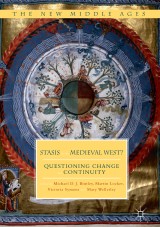Details

Stasis in the Medieval West?
Questioning Change and ContinuityThe New Middle Ages
|
CHF 106.50 |
|
| Verlag: | Palgrave Macmillan |
| Format: | |
| Veröffentl.: | 16.05.2017 |
| ISBN/EAN: | 9781137561992 |
| Sprache: | englisch |
Dieses eBook enthält ein Wasserzeichen.
Beschreibungen
<p>This volume questions the extent to which Medieval studies has emphasized the period as one of change and development through reexamining aspects of the medieval world that remained static. The Medieval period is popularly thought of as a dark age, before the flowerings of the Renaissance ushered a return to the wisdom of the Classical era. However, the reality familiar to scholars and students of the Middle Ages – that this was a time of immense transition and transformation – is well known. This book approaches the theme of ‘stasis’ in broad terms, with chapters covering the full temporal range from Late Antiquity to the later Middle Ages. Contributors to this collection seek to establish what remained static, continuous or ongoing in the Medieval era, and how the period’s political and cultural upheavals generated stasis in the form of deadlock, nostalgia, and the preservation of ancient traditions.</p>
<p>1 ‘Introduction: Stasis in the Medieval West? Questioning Change and Continuity’, Victoria Symons, Mary Wellesley, Michael D. J. Bintley.- 2 ‘Beacons of Belief: Trees and Religion in Britain from Prehistory to the Later Middle Ages’, Michael D. J. Bintley.- 3 ‘The More Things Change, the More They Stay the Same: Decorative Continuity in Early Anglo-Saxon England’, Melissa Herman.- 4 ‘Art History in the Dark Ages: (Re)considering Space, Stasis and Modern Viewing Practices in Relation to Anglo-Saxon Imagery’, Meg Boulton.- 5 ‘Set in Stone or Food for Worms: the Stasis of Writing in the Exeter Book Riddles’, Victoria Symons.- 6 ‘Stitched Up? Cynewulf, Authorial Attribution and Textual Stasis in Anglo-Saxon England’, Tom Birkett.- 7 ‘The House of Stilled Time: Stasis and Eternity in Anglo-Saxon Churches’, Michael Shapland.- 8 ‘There and Back Again: Creating the Pilgrimage Experience in Text’ , Martin Locker.- 9 ‘“But that will not be the end of the calamity”: Why Emphasize Viking Disruption?’, Katherine Cross.- 10 ‘Configuring Stasis: the Appeal to Tradition in the English Reign of Cnut the Great’, Simon C. Thomson.- 11 ‘Sleeping Dogs and Stasis in the<i> Franklin’s Tale</i>’, Richard North.- 12 ‘Static “Menyng” and Transitory “Melodye” in Lydgate’s <i>Seying of the Nightingale</i>’, Mary Wellesley.- 13 ‘Dress, Fashion and Anti-Fashion in the Medieval Imagination’, Louise Sylvester.- Index.</p>
<p>Michael D.J. Bintley is Senior Lecturer in Medieval Literature at Canterbury Christ Church University, UK. His works include <i>Trees and Timber in the Anglo-Saxon World </i>(ed. with Michael Shapland); <i>Trees in the Religions of Early Medieval England</i>; <i>Representing Beasts in Early Medieval England and Scandinavia </i>(ed. with Tom Williams); <i>Andreas: an Edition </i>(ed. with Richard North); and <i>Sensory Perception in the Medieval West </i>(ed. with Simon Thomson).</p>Martin Locker<b> </b>Martin Locker completed his PhD on Medieval Pilgrimage at the Institute of Archaeology, University College London. His thesis has been published by Archaeopress as <i>Landscapes of Pilgrimage in Medieval Britain </i>(2015). His research interests include medieval religious culture and its expression in the landscape. He is now an archaeologist with Oxford Archaeology and a freelance editor.<div><br/>Victoria Symons is a Teaching Fellow in Old and Middle English Literature at University College London. Her research focuses on medieval uses of visual communication and the written word. She has published on runes, Old English riddles and charms, and the Franks Casket. Her first book, <i>Runes in Anglo-Saxon Manuscripts</i>, is due to be published in 2016. <p>Mary Wellesley<b> </b>works in the Department of Ancient, Medieval and Early Modern Manuscripts at the British Library in London. She was educated at Lincoln College, Oxford, before moving to University College London for her Masters' and PhD. She has published on aspects of codicology, literary criticism, on medieval drama and on Lydgate's religious verse. Also a freelance writer, her work has appeared in <i>Apollo</i>, <i>Archipelago</i>,<i> Lapham’s Quarterly.</i></p></div>
<p>This volume questions the extent to which Medieval studies has emphasized the period as one of change and development through reexamining aspects of the medieval world that remained static. The Medieval period is popularly thought of as a dark age, before the flowerings of the Renaissance ushered a return to the wisdom of the Classical era. However, the reality familiar to scholars and students of the Middle Ages – that this was a time of immense transition and transformation – is well known. This book approaches the theme of ‘stasis’ in broad terms, with chapters covering the full temporal range from Late Antiquity to the later Middle Ages. Contributors to this collection seek to establish what remained static, continuous or ongoing in the Medieval era, and how the period’s political and cultural upheavals generated stasis in the form of deadlock, nostalgia, and the preservation of ancient traditions.</p>
Destabilizes popular misconceptions of the medieval period, showing the richness and diversity that Medieval Studies can yield Offers a rich and interdisciplinary set of essays relevant to the fields of literature, history, art history, linguistics, and archaeology Addresses a range of topics and periods encompassed within the field of medieval studies while maintaining narrative and thematic coherency throughout
<p>“This book identifies an issue that has never been discussed in such an encompassing way before. What makes the volume particularly interesting and valuable is that it resists a ‘cookie-cutter’ approach to the topic, emphasizing instead the complexities and contradictions that are inherent in attempting to identify stasis under dynamic cultural and literary conditions. It introduces to the general reader the result of research that specialists may be aware of, but which has not yet been generally disseminated.” (Shaun F. D. Hughes, Professor of English Literature, Purdue University, USA)</p>
Diese Produkte könnten Sie auch interessieren:

The Enigma of Good and Evil: The Moral Sentiment in Literature

von: Anna-Teresa Tymieniecka

CHF 354.00















